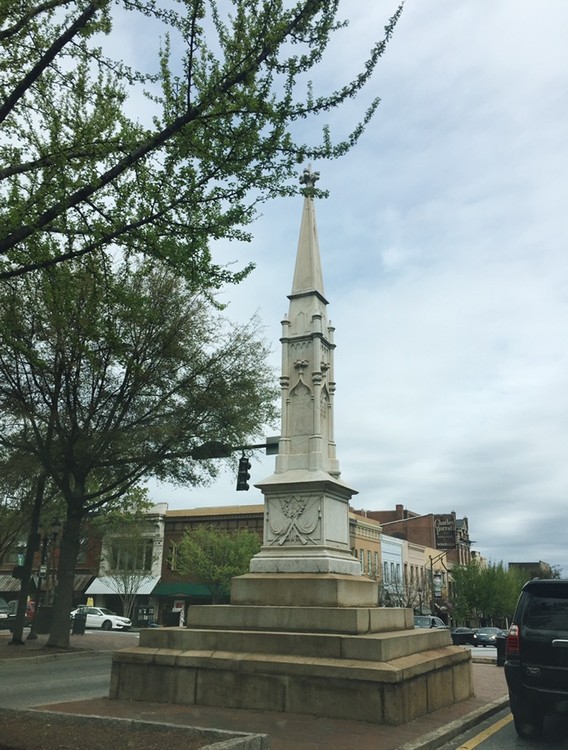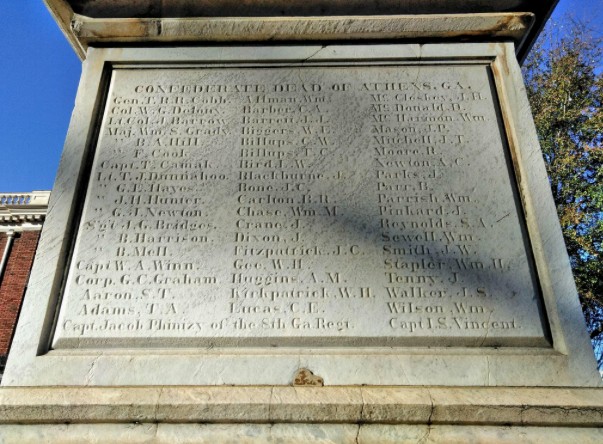Confederate Monument
Introduction
Text-to-speech Audio
Images



Backstory and Context
Text-to-speech Audio
The Confederate Monument in Athens was erected by the Ladies’ Memorial Association in Athens on May 5, 1871. By this date, there were only eight other Confederate Monuments in the South, and only one other in the state of Georgia.1
Ladies’ Memorial Associations were by and large responsible for memorializing the Confederacy throughout the southeastern United States in the later 19th century. The responsibilities of the LMA included decorating Confederate graves, moving the remains of Confederate soldiers to cemeteries, and erecting monuments to their memory. These local chapters of the greater Ladies’ Memorial Association sprouted out of the wartime Ladies’ Aid Society.2 Members of this Society sought to honor their husbands and Confederate soldiers. It became a woman’s wartime civic duty to support the Confederate cause in any way they could; more often than not, due to the fact that Confederate Soldiers were 2.5 times more likely to die in uniform than a Union Soldier,3 that duty looked like finding and burying the remains of soldiers. Thus, when the war was over, it was only fitting that these Societies would continue to tend to the graves of soldiers and erect monuments in their respective towns.4 Because many white Southerners believed their cause to be honorable and moral, “homage and public celebration” are the “only possible outcomes” of memorialization.5
The monument in Athens was no exception to this idea of Confederate honor and loyalty. The LMA put forth a great deal of effort to fundraise for the erection of the monument. According to Augustus Longstreet Hull in his Annals of Athens, private investments were the sole source of fundraising for the monument. No government or federal funding, or even federal permission, was dedicated to the Athens monument, unlike many later monuments.6 From the first Confederate Memorial Day which took place on May 4, 1866 to the day the monument was erected in 1871, the LMA in Athens worked tirelessly to fundraise for the construction of the monument. There were concerts, plays put on by University Thespian Groups and fairs, all advertised under the banner of “Come one, come all, and let us raise our monument; let it be reared on high, so our children’s children may from it learn how our brave ones died”.7 After the monument was instated on the corner of Washington Street and College Avenue in 1871, even more money needed to be raised for what was written by University Chancellor Andrew Lipscomb to be inscribed on the monument by a mason in Augusta. The inscriptions include a poem, a nod to the Ladies’ Memorial Association, and six statements of honoring the Confederate dead. By 1872 and $4,444.44 later, the monument was complete.8
All businesses and schools were temporarily closed so that all the citizens of Athens and Clarke County could take part in a procession and celebration that started at the University Chapel, made its way to the original site of the monument, and ended by decorating Confederate graves in the Oconee Cemetery. At both the unveiling ceremony in 1871 and the inscription ceremony in 1872, speeches were made. The first speech was made by Albert L. Mitchell, a local Confederate Veteran. The second speech was made by Alexander Erwin, another Confederate Veteran who “predicted that the South would rise out of its present low estate forced upon it by the atrocious Reconstruction policies of the Radicals".9
Shortly after these processions, life continued in Athens. As cars became more popular, the location of the Confederate Monument caused it to be “looked upon more as an impediment than a sentiment”.10 Since its instatement, the monument has been moved twice: firstly a block northward from its original location, and secondly two and a half blocks southward to its current location of College Avenue and the middle of Broad Street.
In the wake of the monument incident in Charlottesville in 2017, a city-wide meeting was called to discuss the potential removal of the Confederate Monument in Athens. However, as of now, there are no real administrative decisions being made.
Sources
Notes
1Coulter, E.M. "The Confederate Monument in Athens, GA" p. 3
2Coulter, E.M. "The Confederate Monument in Athens, GA" p. 5
3Moltke-Hansen, David. “Honoring Confederate Defeat the Georgia Way.” p. 8
4Case, Sarah H. “The Historical Ideology of Mildred Lewis Rutherford: A
Confederate historian’s new south creed.”
5Moltke-Hansen, David. "Honoring Confederate Defeat the Georgia Way." p. 9
6Hull, Augustus Longstreet. Annals of Athens. p. 338
7Coulter, E.M. "The Confederate Monument in Athens, GA" p. 11
8Coulter, E.M. "The Confederate Monument in Athens, GA" p. 15-18
9Coulter, E.M. "The Confederate Monument in Athens, GA" p. 15
10Coulter, E.M. "The Confederate Monument in Athens, GA" p. 19
Works Cited
Athens City Directory. M.C. Pope & Co., Athens, 1889.
Case, Sarah H. “The Historical Ideology of Mildred Lewis Rutherford: A Confederate historian’s new south creed.” The Journal of Southern History. Athens, Vol. 68, Iss. 3 (Aug 2002): 599-628.
Coulter, E.M.. "The Confederate Monument in Athens, GA." Georgia Historical Quarterly. Georgia Historical Quarterly, September 1956.
Hull, Augustus Longstreet. Annals of Athens. Athens, Banner Job Office, 1906.
Moltke-Hansen, David. “Honoring Confederate Defeat the Georgia Way.” Georgia Historical Quarterly. March 1, 2017.
